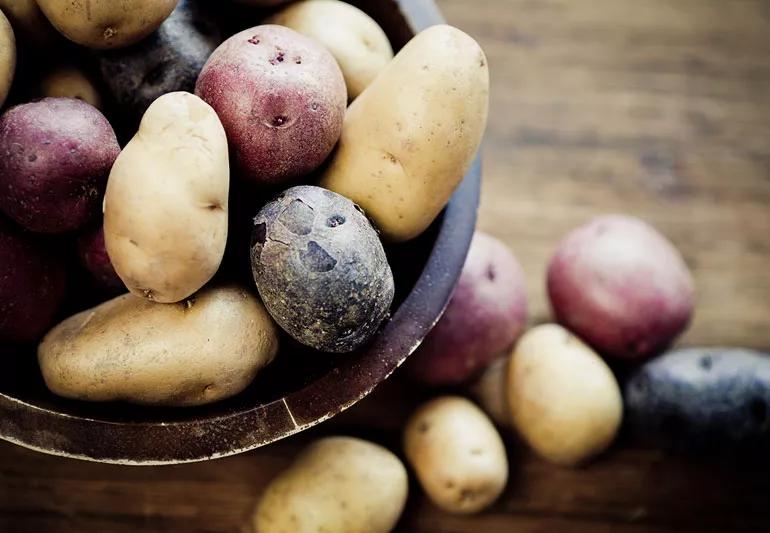Potatoes aren’t the enemy — here’s why and how to eat them

Of all the vegetables Americans eat, potatoes are among the most popular – the average American eats about 55 pounds of potatoes a year. Some people call potatoes diet-wreckers. But others say they’re fine to eat.
Advertisement
Cleveland Clinic is a non-profit academic medical center. Advertising on our site helps support our mission. We do not endorse non-Cleveland Clinic products or services. Policy
Registered dietitian Andrea Dunn, RD, explains the benefits of potatoes and how you can enjoy them without sabotaging your healthy eating goals.
Are potatoes a vegetable or a starch? This age-old question can lead to arguments about their health benefits. After all, calling something a vegetable seems to magically change it into a healthier food.
“Potatoes are put in the starchy vegetable category, due to the amount of carbohydrates they contain,” says Dunn. “But they are a type of vegetable and they contain plenty of vitamins and minerals.”
The two main types of vegetables are starchy and non-starchy. Starch is a type of carbohydrate that we find in lots of foods. Other types of carbs are fiber and sugar.
Starchy vegetables are higher in total carbohydrates than their non-starchy counterparts. Usually, this means starchy veggies are higher in calories, too. Other starchy vegetables include:
Non-starchy vegetables include:
But the higher calorie content doesn’t make potatoes a diet no-no. Like any food, potatoes are fine to eat in moderation.
“Healthy food choices should include a variety of starchy and non-starchy vegetables,” says Dunn. “In fact, the new Dietary Guidelines for Americans includes up to 5 cups a week of starchy vegetables for those needing 2,000 calories a day.”
Advertisement
Potatoes come in many varieties that differ in taste, texture and color. Some of the most common types include:
Each type varies slightly in terms of its vitamin and mineral content. But the differences are pretty small.
And sweet potatoes aren’t a type of potato, despite their name. “Sweet potatoes come from a different plant family than potatoes so their nutrition content is different,” says Dunn. “One of the main differences is that sweet potatoes contain vitamin A and white potatoes don’t.”
Potato nutrition
Wondering if potatoes measure up to other veggies in terms of nutrition? One medium-sized russet potato baked with skin offers:
To get the full nutrition, don’t peel your potatoes. “The skin has half of the potato’s fiber content and many of its nutrients,” says Dunn.
One of the reasons people may avoid potatoes when they’re trying to eat healthy is because of the cooking method, not the vegetable itself. Any food soaked in butter, deep fried or topped with sour cream will pack on the calories. Not to mention all the excess salt that often goes along with them (hello, bloating).
But potatoes can be a healthy and delicious choice if you use these cooking methods:
Be mindful of what you put on top. “Try a drizzle of olive oil with chives instead of sour cream, butter and salt,” says Dunn.
Looking for some ideas that add a little zip to your potatoes without all the calories? Try these recipes for healthy and tasty ways to enjoy your spuds.
Potatoes aren’t the diet villain they’ve been made out to be. Skip the fries and enjoy your potatoes using healthy cooking methods. And be sure to include plenty of other fruits and veggies in your diet, too.
Advertisement
Advertisement
Learn more about our editorial process.
Advertisement

Eating this root vegetable can help support your eye, heart and brain health

This fermented cabbage is full of probiotics and fiber, and can help your gut, heart and brain health

This root veggie can also benefit your gut, heart and eyes

As the stalky vegetable breaks down, it leaves behind sulfuric byproducts that can make your pee stink

Most of the time, beeturia is a curiosity, not a concern

This cruciferous veggie boosts your bone, eye and heart health and contributes to a lower risk of cancer

Some diets shun them, but research hasn’t concluded that they’re harmful

This versatile type of seaweed may help support weight loss, bone health and cancer prevention

Start having sex about 72 hours before ovulation, then at least every other day during your fertile window

Attachment theory suggests that your earliest relationships shape connections throughout your life

It isn’t a recognized mental health disorder, but research shows that problematic social media use can negatively affect your mental health, self-esteem and sleep